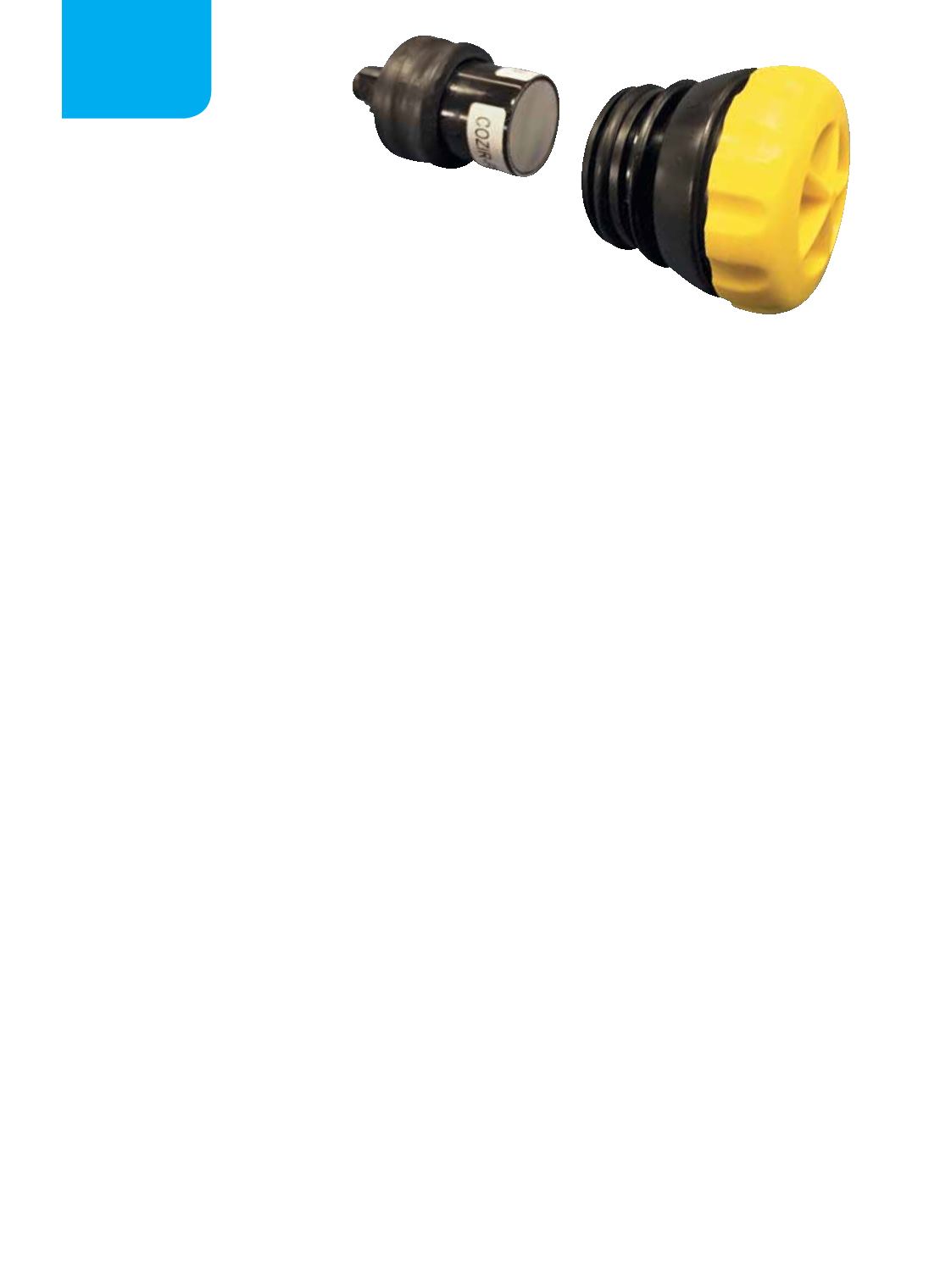

U
nlike an open-circuit diver, who
breathes a known, predetermined
gas mixture (
You do analyze your
gas before diving, don’t you?
),
a rebreather diver respires an
artificial atmosphere that changes
dynamically with depth over the course of a dive.
An electronic rebreather has two jobs: to measure
and maintain a preset level of oxygen (partial pressure
of oxygen, or PO
2
) using oxygen (O
2
) sensors and a
controller, and to remove the diver’s exhaled carbon
dioxide (CO
2
) by means of a chemical scrubber. Until
recently there was no way to detect the presence of
CO
2
in the breathing loop — that is, to know if the
rebreather was working properly.
CO
2
detection has long vexed the U.S. Navy, which
has spent millions of dollars over the past 50 years in
search of a solution, and for good reason: Hypercapnia
from elevated CO
2
levels in the loop is a major hazard
in rebreather diving. It can lead to incapacitation, loss
of consciousness and death in amounts greater than
0.01-0.02 atm.
Divers tend to be poor at detecting increased CO
2
,
especially when exerting themselves. By the time they
detect it, the situation is usually perilous, requiring a
rescue rather than a bailout. Appropriately dubbed
the dark matter of rebreather diving, CO
2
may be
responsible for or a contributing factor in as many as a
third of sport rebreather fatalities.
In the past five years, as a result of a breakthrough
in commercial technology, several sport rebreather
manufacturers have introduced nondispersive infrared
(NDIR) sensors that warn divers of elevated CO
2
levels,
indicating a possible scrubber failure. Though the
technology is still in its infancy, it holds promise for
improving diver safety.
Meanwhile, the Navy Experimental Diving Unit
(NEDU), which has tested dozens of NDIR devices
with limited success due to problems with water
vapor and pressure effects, is currently beta testing an
innovative sensing film for use in oxygen rebreathers
that could revolutionize CO
2
detection.
DARK MATTER IN THE LOOP
Divers produce about 0.9 liters of CO
2
for every liter of
O
2
they consume. A properly functioning rebreather
removes this gas from the breathing loop. Even so,
CO
2
can accumulate in several ways. First, inspired
CO
2
levels rise exponentially once the scrubber reaches
depletion, which is known as “breakthrough.”
Feeling lucky? Although manufacturers publish a
worst-case scrubber duration, actual duration can vary
high or low by a factor of four times depending on a
diver’s profile and workload, the water temperature and
even the brand of CO
2
absorbent used in the scrubber.
Improperly filling or installing the scrubber or
forgetting to grease the scrubber O-ring can result in
channeling or bypass, allowing CO
2
to be rebreathed.
So can a dirty “mushroom valve,” a one-way valve that
directs the diver’s exhalation to the scrubber.
Finally, divers eliminate CO
2
by breathing, and CO
2
levels in a rebreather diver’s arterial blood can rise to
dangerous levels as a result of insufficient breathing.
In fact, the combined effects of immersion, static
lung loading, increased gas density and having to
push gas through the loop with the lungs can reduce
a rebreather diver’s capacity to ventilate by about 50
percent at 100 feet, and it continues to decrease
with depth.
In the absence of a means to detect CO
2
, military
divers have relied on strict protocols for preparing
their rebreathers, including a five-minute prebreathe
to detect possible problems. However, a recent study
1
found that 90 percent of subjects failed to detect a
partially faulty scrubber during the prebreathe. This
illustrates the great need for reliable sensors.
In 2001, under pressure to reduce “scrubber crashes”
in the fleet, NEDU released a patented scrubber
thermal array that measures the heat of the chemical
reaction as CO
2
moves through scrubber. AP Diving
developed its own array, called a TempStik, in parallel.
Though not foolproof, these devices function as a sort
of gauge to estimate how much CO
2
absorbent has
been used and how much remains, greatly reducing
uncertainty about scrubber duration.
110
|
WINTER 2016
GEAR
DO YOU KNOW WHAT
YOU’RE BREATHING?
CO
2
SENSING IN REBREATHER DIVING
By Michael Menduno
















